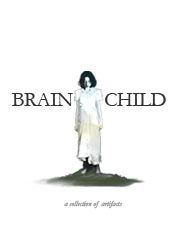Brainchild
First off, I must admit that this is the first chapbook that I’ve ever read and quite purposefully at that, as it is a medium that I’ve had certain predisposed low expectations of. I assumed chapbooks to be scatterbrained collections of varying quality, half-realized stories and unrelated out-of-place drawings. Boy, was I wrong!
To my surprise, Brainchild is presented in a very methodical way with a very clever theme in mind. It is a collection of artifacts, as in evidence left behind in the wake of some catastrophic zombie epidemic. There is a very interactive feel to the way things flow together, as if you’ve stumbled across these personal accounts in some future time and are delineating the ambiguous clues to piece together a fractured history. From one story to the next, there is a growing sense of doom and an overwhelming sense of the horror of it all. One is compelled to continue reading, as if bearing witness, and assuming the mantle of a living chronicle.
Many different aspects of the personal experience are presented, from desperate victims, to stalwart survivors, to the hopeless infected. The pace of these accounts is brisk, as if the authors were pressed and had to impart what they knew and move on. Each story captures a feeling of progression from the previous; from the opening lines that illustrate the initial moments of an outbreak, to “Running” a short story about the instinctual need to flee, to “Black Days: Sandy” an account from a victim’s perspective, to “Black Days: Paul” a story about a survivor relentlessly focused on living in a horrible new world, and finally to “Book Of Matches”, a hopeless tale about soon-to-be zombies taking fate in their own hands. There are many other tales filling the remarkably ample 64 pages, yet these standouts demonstrate the feeling of passing time most deftly.
The recurring artwork in Brainchild offers reflective moments in between each story, and like each story, one assumes the differing pieces of art to be personal observations from casualties and survivors of the zombie outbreak. The artistic styles are as random as the mediums used. From stark paintings, to expressive drawings, to surrealistic altered photos, each piece is engrossing and fits the ambience perfectly. Some impressive skill is shown in quite a few of the works, yet the most simple and most disturbing piece is the crayon rendition of an undead killer drawn by a child. It is a chilling glimpse of a terrifying world through the eyes of innocence and is a harsh reminder of who would be the most helpless of victims.
The one shortcoming of Brainchild may be the inclusion of the essay “My Zombie Girlfriend” about the history of women in zombie literature and film. The essay itself is not so much to fault, although I don’t think it achieved its point too well, but rather it is it’s incorporation into this make-believe world of zombie historian that doesn’t gel. It is the one unrelated piece that does not fit the theme and it detracts from the captivating role-play of the reader. However, one can assume that the essay’s inclusion was for the sake of diversity and as such is forgivable for the sake of the whole.
Brainchild is obviously a very ambitious project and a labor of love by some very talented people. It certainly should meet or exceed anyone’s expectations of a work of this kind. I was quite surprised with the professionalism, presentation, and well-crafted execution. Everyone involved with the project is disserving of praise and hopefully will have much more to offer in the future.
Review by !Vision! (Brandon Begley)

